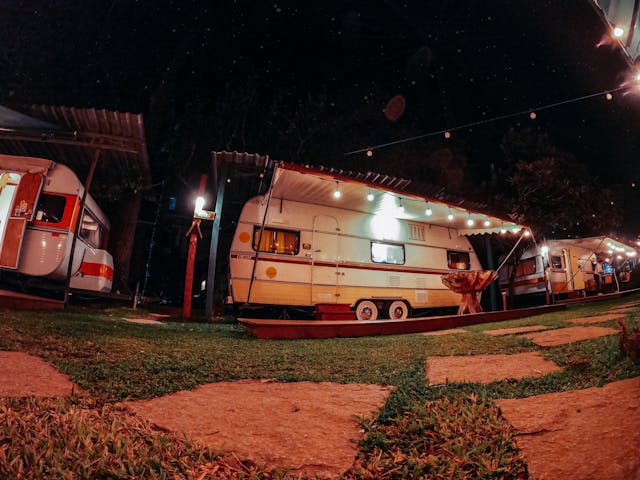If you were to delve into insulation research, you’d mostly encounter solutions tailored for RVs. However, many of these same solutions can effectively enhance the insulation of your trailer.
It’s time for trailer owners to receive the recognition they deserve. In this article, I’m compiling five fantastic methods to regulate temperature inside your trailer using insulation. While not exclusively designed for trailers, most of these methods can be adapted for them.
Before we dive in, there are two important points to note. Firstly, it’s not advisable to spend winters camping in a trailer, even with the insulation methods I recommend. Trailers often suffer from air leaks and typically have minimal insulation, usually fiberglass. These factors can pose challenges.
Secondly, let’s briefly discuss the concept of R-value, as it will be referenced frequently. The R-value indicates the efficiency of insulation in maintaining a consistent temperature. The higher the R-value, the better the insulation performs. While R-values vary depending on the climate zones across the country for household insulation, for mobile vehicles like trailers, the specifics of zone differences are less critical. Just remember, higher R-values equate to better insulation.
Without further delay, here are five effective ways to insulate your trailer.
1. Upgrade Your Windows
Many trailers come equipped with single-pane windows, notorious for their poor insulation capabilities. These thin and inexpensive windows allow cold or warm air to easily infiltrate your trailer, leaving you uncomfortable.
If you’re considering a change, you have two options. The first, and often optimal, choice is to replace the windows entirely. However, this may come with drawbacks such as cost and potential warranty issues.
Understanding these concerns, I’ll also outline how to insulate single-pane windows. While not as effective as window replacement, these steps can still make a noticeable difference in your trailer’s insulation.
Replacing the Windows
Step 1: Measure the size of your trailer windows accurately to ensure you order the correct replacements. Trailer windows come in various types, including awning windows, vertical sliders, horizontal sliders, and jalousie windows. Each type offers different features and benefits.
- Awning Windows: Featuring dual opening glass panes, awning windows are suitable for mid-sized trailers.
- Vertical Sliders: These tall windows open via a slide on tracks, providing ample ventilation.
- Horizontal Sliders: Similar to vertical sliders but open sideways, these windows are a space-saving option.
- Jalousie Windows: While offering great views, jalousie windows have poor sealing, making them a compromise in terms of insulation.
Step 2: Once you have the new window(s), uninstall the current ones by removing the window frame. For windows with metal or vinyl siding, you may need to remove the siding first.
Step 3: Scrape away any remaining caulk or putty from the window area.
Step 4: Install the new window, ensuring a snug fit, and use fresh sealant to secure it in place. Consider purchasing new screws and siding for better insulation performance.
Insulating the Existing Windows
If replacing your windows isn’t feasible, or you prefer to improve the insulation of your current windows, here are some alternative methods to consider:
- Apply Plastic Insulating Film: Invest in plastic insulating film, an affordable option to enhance window insulation. Simply cover both sides of the window with the film and use the provided double-sided adhesive tape to secure it in place. Then, use a blow dryer to create an airtight seal across the film. While not the most aesthetically pleasing solution, it effectively improves insulation.
- Wrap the Windows in Bubble Wrap: For a budget-friendly option, consider wrapping your windows in bubble wrap. Begin by spritzing water onto both the inside and outside of the window to provide moisture for the bubble wrap to adhere to. While this method may not win any design awards, it offers a practical way to enhance insulation.
2. Reseal Doors
Now that your windows are taken care of, it’s time to tackle another area where major cold/heat loss occurs: your doors.
If your trailer doors don’t have weatherstripping, that’s the first thing you can change. You can order weatherstripping online or pick it up at any home improvement store. If you own a house, then you’ve seen weatherstripping in action. This strip of bulky fabric sticks beneath your front door to prevent drafty air from disrupting the coolness or warmth of the interior.
A door snake serves the same purpose as weatherstripping and can be made as easily as taking a dish towel, rolling it, and putting under your door. Again, does this look good? Nope, but if you’re inside for the night, who cares?
The last method is more time-intensive, as it’s a DIY job. It involves reapplying a fresh layer of caulk around your trailer doors. You should do this at least annually (or about every two years) anyway, so it’s good to get into the habit now. If you notice any holes, cracks, or small spots, add extra caulk to them. That should cut down on draftiness.
3. Seal Your Vents
If you’ve already insulated your windows and doors but still feel drafts in your trailer, it’s possible you’ve overlooked your vents. Situated higher up in your vehicle, vents are often forgotten but play a crucial role in regulating humidity and moisture.
While vents are essential for maintaining comfort and preventing mold and mildew, they can also allow unwanted hot or cold air to infiltrate your trailer. The solution? Invest in a vent cushion!
The Camco vent cushion stands out as a top choice, boasting a five-star rating on Amazon and earning the coveted Amazon Choice designation. Priced at $14.99, it’s a budget-friendly option for enhancing insulation in your trailer. Designed for RV and trailer vents measuring at least 14 inches, you can customize it to fit smaller vents by cutting or compressing it.
You have the option to choose between a cushion with or without a reflective surface. While the non-reflective cushion is slightly more expensive, both options provide effective insulation. The reflective version offers additional UV protection.
Remember, it’s essential to remove the cushion before using your trailer’s vents. With its easy-to-use design, you’ll wonder how you ever managed without it.
4. Skirt Your Trailer
Skirting is a technique more commonly associated with RVs than trailers. However, there’s no reason why you can’t skirt your trailer too. After all, the underside of your trailer is just as susceptible to temperature fluctuations from the outdoors as an RV’s.
But what exactly is skirting? It involves wrapping a layer of fabric around the bottom half of your vehicle, extending down to the ground. This “skirt” acts as a barrier, preventing excess cold or heat from entering underneath and into your trailer. Plus, it adds a touch of charm to your vehicle’s appearance.
While skirting is more prevalent among RV owners, it’s still possible to skirt your trailer. You may need to purchase an RV skirt and trim it down to fit your trailer’s dimensions.
RVSkirting.com offers specialized skirts designed specifically for fifth-wheel trailers. Alternatively, you can explore custom sizing options with them or other manufacturers.
Why Skirt Your Trailer? According to TripSavvy, skirting can effectively control interior temperatures, potentially reducing propane usage during cooler months. With less fuel needed to keep your vehicle warm, skirting offers both practical and economical benefits.
5. Reinforce Your Walls with Insulation
At the outset of this article, we discussed how most trailers come equipped with a thin, inadequate layer of fiberglass insulation on the walls. However, even with the implementation of other insulation tactics, you may still find yourself lacking in comfort.
Reinsulating your walls offers a comprehensive solution to enhance temperature control in your trailer. It’s worth noting that undertaking this task yourself may void any existing warranties, so it’s advisable to consult with your trailer manufacturer beforehand, especially if considering professional assistance.
Once you’ve addressed any warranty concerns, you’ll have several insulation materials to choose from:
- Spray Foam: Ideal for DIY projects, spray foam offers simplicity and effectiveness. With a relatively high R-value, spray foam expands from a canister or similar container upon application, resembling shaving cream. Once settled, it provides improved insulation for your walls.
- Rigid Foam: Another option is rigid foam, which can be customized to fit your needs by cutting it to size. This pink foam boasts a good R-value and requires industrial tape or caulk for attachment to the walls. Known for its strength, durability, and moisture-resistance, rigid foam offers effective insulation, albeit with a more challenging installation process compared to spray foam.
- Fiberglass Foam: If you prefer to augment your existing insulation rather than replace it entirely, fiberglass foam insulation is worth considering. While it offers a good R-value and effectively retains cool air during summer months, it’s important to note that fiberglass insulation may expand when warm and may need to be replaced every few years. Additionally, there’s a risk of mold growth if moisture penetrates the insulation. Regular inspections are crucial to detect any signs of mold early on.

